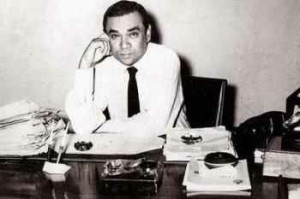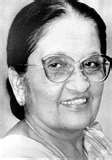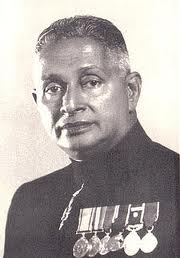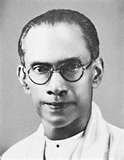Mervyn de Silva’s progressive realism in world affairs
12th Death Anniversary (June 22)
‘The Bandung conference…symbolized the climax of the anti-imperialist movement in espousing ideals that were greater than the nation.” (Prasenjit Duara, ‘The Global and Regional in China’s Nation-Formation’, Routledge 2009, p.61)
In his controversial book The Cage, the best known anti-Sri Lanka publicist, former UN spokesperson Gordon Weiss, had this, among other things to say: “Dayan Jayatilleka, one of the most capable diplomats appointed by the Rajapakse regime, had outmanoeuvred Western diplomats to help Sri Lanka escape censure from the UN Human Rights Council in Geneva. He had also been one of the most trenchant advocates within the government for meaningful constitutional reform, including the devolution of power to the provinces”. (p. 256-7)
As for the first of these observations, my contribution owes much to the influence and orientation of my father Mervyn de Silva. If the first and second statements are two faces of a coin and the combination constitutes a specific synthesis, perhaps more dissentient than dominant in a polarised place, this derives not only from Mervyn’s stance but is a return to it, having attempted to range, radically, far beyond. That journey is not only a personal ‘return to the source’ (to borrow the title of a collection by Amilcar Cabral, the great African liberationist) occasioned by the attritions of age, but the accumulation of evidence that the struggles of Mervyn’s generation on the intellectual battlefronts of ideas and values, remain to be re-fought in the new century.
Mervyn de Silva saw Sri Lanka in its relationships, external and internal, not as a self contained, self-centred or self sufficient entity. He understood the island as embedded in its regional and global context, which consisted of elements of continuity and change. He attempted to transmit this understanding to Sri Lankans, acting as the great educator of citizens in the domain of international relations, while he also strove to interpret to the world, through the international media, that which was specific to Sri Lanka.
Mervyn belonged to the best educated generation of Sri Lankans or Ceylonese, the ones of the greatest achievements in their chosen professions, vocations or fields, who etched a presence in the wider world. This generation, the emerging intellectual and social elite of post-colonial opinion makers, and the product of the country’s education system at its zenith, were not homogenous. Mervyn, entering university bagging the top prizes for English literature at Royal College having edited the prestigious college journal and going on to edit the university magazine, belonged prominently to the category of cosmopolitans. The cosmopolitans were themselves bifurcated, though that bifurcation was more a tripartite demarcation. They were split between the Marxists and those in sympathy with the Anglo-American camp, with the former engaged in fratricidal strife between the Trotskyites and the Stalinists.
Mervyn belonged to that stratum, widespread in the newly independent countries, which was westernised in terms of literature and culture, but in political and intellectual opposition to imperialism and neo-colonialism. A contemporary, Gamini Seneviratne, ruefully recalls him as being sympathetic to the Communist (‘Stalinist’) tendency, and his almost visceral allergy to the Trotskyist LSSP was long remembered (an antipathy balanced but not belied by personal friendships with the more refined of their leaders and ideologues). However, even in his undergraduate youth Mervyn was far too evolved, mature and lucid (a liberal humanism derived from a precocious literary critical sensibility had much to do with it), to commit to the Marxist Left and a universalist-Utopian collective enterprise.
A space opened up for the independent minded such as Mervyn, with the Bandung moment in 1955 and the emergence of Afro-Asianism, which was to mature into the Non Aligned Movement as the next decade dawned. Here was a project which was anti-imperialist but was not narrowly nationalist, nativist or backward looking; it was led by progressive, modernist, modernizing and mainly secular leaders of the newly independent nations such as Nehru, Nasser, Nkrumah, and Nyrere. Here was an emancipatory enterprise that contained the type of Communists that Mervyn respected (Chou en Lai in Bandung, Ho Chi Minh and Fidel in NAM), but was not a Communist project. This was the global space with which Mervyn identified most, politically, intellectually and emotionally. Though the vocation of journalism was home, the Third World/NAM project and movement comprised a space that was closer to him than anything exclusively Sri Lankan.
It was as part of this identification with a Third Space (Mervyn’s phrase from his intervention in the debate on the New International
Information Order) that led him to identify with SWRD Bandaranaike and the SLFP. SWRD was the Ceylonese counterpart of the Bandung project of Afro-Asianism. At Bandung, Ceylon was represented by the pro-Western Kotelawela who attempted an ideological confrontation with Chou En Lai, a ludicrously off-key mismatch with a master of 20th century diplomacy. Mervyn identified far more with Chou En Lai than with the crude Cold war conservatism of Sir John. A year later, in SWRD Bandaranaike and the SLFP/MEP, he saw the country’s vehicle and pathway into that new historical movement. This was to continue with SWRD’s widow Sirimavo and Sri Lanka’s presence at the founding conference of the Non Aligned Movement at Belgrade in 1961. While he covered the 2nd NAM summit in Cairo in ’64, the evolution of Mervyn’s consciousness and stance paralleled the radicalisation of the NAM from the Algiers summit of ’73, through to the Havana summit of ’79, from which he reported with engagement and enthusiasm on Castro’s performance as incoming chairman.
The matter was always fraught. Mervyn had welcomed and supported –but never joined –the SLFP as the domestic equivalent of the independence seeking, newly emergent forces of the post colonial world, which in turn drew inspiration from and reached out to the liberal and progressive heritage of and currents in the West. However, the chosen vehicle, the SLPF led bloc and the State under its direction — indeed the only available agency for Mervyn and those like him — was quite distinct and significantly different from its counterparts in the Third World, and even in Asia and South Asia.
As a party formation, the SLFP consisted of and represented the same social elements and ideological discourse that Mervyn disdained in his youth and throughout his life, the nativist chauvinists (and religious-chauvinists). It was Sri Lanka’s tragedy that the counterpart of the Bandung-NAM leadership was ideologically and socially very different from the modernist statist patriots such as Nehru, Tito, Nasser and Castro. SWRD Bandaranaike may have been Ceylon’s Nehru in his education, foreign policy and personal world outlook, but the SLFP was more a BJP than a Congress, which makes it possible that in the eyes of History, he may be seen more as a Jinnah than a Nehru, or somewhere in between. Sirimavo Bandaranaike’s SLFP was certainly no secular Congress party. It never recovered (even under Chandrika Kumaratunga) its potential as defined by its founder at its inception in the early 1950s, as a social democratic centrist alternative. Mervyn felt that while it trod the Middle Path in foreign policy, it failed to do so in domestic policy as regards the ethnic question.
His discourse was never anti-national or anti-nationalist; he was in strong sympathy with Third World nationalisms, and admired the radical and revolutionary-emancipationist variants (from Fidel to Fanon). His critique of the LSSP’s Trotskyist lineage was of its underestimation of nationalism, especially peasant nationalism with its cultural dimension. Yet he was even more critical of what he considered the Sinhala chauvinist mindset and its congenital inability to grasp ‘the global’ (chastising in his ‘Kautilya’ column the isolationists who saw the country as a viable garrison state, as the ‘Gonthadiya School of Strategic Studies’). While he was hardly describable as primarily a nationalist, the nationalist aspect of Mervyn was trans-ethnic and non-religious, Ceylonese or Sri Lankan instead of Sinhala or Sinhala-Buddhist; broad, liberal, inclusive, pluralist and internationalist. The Sri Lanka that approximated Mervyn’s hopes would have been essentially the same as that which the liberal within SWRD strove for: the ‘Silent revolution’ and emergence of the two party system in ’56 swiftly followed by the ’57 B-C pact’s ‘course correction’ of devolution, placed within the foreign policy envelope of Non Alignment followed by successive SLFP administrations. He saw in Premadasa a variant and continuation, commented favourably on him from mid-career and was supportive and accessible for advice throughout Premadasa’s presidency.
The contradiction had to come to a head. When Mervyn was made editor of the Daily News in 1970, Tamara Deutscher, widow of the iconic Isaac Deutscher, referred to it in the New Left Review as Lake House “parading a bit of pink camouflage”, which was true enough, since Mervyn was more authentically ‘pink’ than ‘blue’, ‘green’ or ‘red’. By age fifty, he had been sacked in quick succession by the SLFP and UNP administrations, and founded the Lanka Guardian. In his 50s and 60s, the last two decades of his life –its final stage—he became manifestly what he was (in the Nietzschean sense of ‘become what you are’) and could be measured against the backdrop of what TS Eliot called ‘Tradition and the Individual Talent’.
While regime hubris was at its height with a two-thirds majority, the suppression of the ’71 insurrection, Emergency rule and the promulgation of the new Republican constitution, Mervyn had prophesied editorially in the Daily News in ’72 about the militant disaffection of the Tamil youth in the North; a disaffection in which the socioeconomics of the Southern youth insurrection were compounded he noted, by a strong sense of ethno-linguistic discrimination. A decade later, after July ’83, he stressed that Sri Lanka’s Tamil issue was no longer a purely domestic issue and was now ‘externalised’, becoming an ‘inter-mestic’ (Kissinger’s term) problem for both Sri Lanka and India, i.e. one at the interface of international and domestic politics.
A year after Black July ’83, he convened the Lanka Guardian-United Nations University South Asia Perspectives Project which produced a detailed draft programme and vision for the future, having as centrepiece, a scheme of moderate devolution of power to Provincial Councils. It was signed by a multiethnic group of Sri Lanka’s foremost intellectuals of that time as well as a clutch of younger personalities who were to become their (rather less stellar) successors. The recommendations were never implemented.
Under Mervyn’s editorship the Lanka Guardian supported, just as he did in his ‘Kautilya’ column in The Island, all efforts at a political settlement based on devolution (especially those negotiated with the TULF led by his campus contemporary Amirthalingam), the post ’83 negotiations between Colombo and Delhi, and the Indo-Lanka accord, despite evidence that he had made the JVP-DJV list of enemies (who were usually murdered). He took this most risky of stances for two reasons.
Firstly, he understood the realities of power and geopolitics, and that Sri Lanka, due to and despite the delusional braggadocio of JRJ’s more militaristic ministers, had isolated itself, with its allies and firmest friends urging a deal with Delhi. Secondly, he scoffed at the idea that autonomy was coterminous and co-extensive with or an antechamber to secessionism, and from his encyclopaedic awareness of world affairs, was convinced that the separatist cause can be defeated and support for it drastically eroded only by some form of autonomy, just as violent revolution can only be deflected by timely reform– and that this was precisely why Prabhakaran was fighting a war against the Indian peacekeeping force to prevent the implementation of the Accord.
In world politics, Mervyn remained a ‘progressive Realist’, criticising uni-polar interventionism, seeking out the positive trends towards multi-polarity while reminding Sri Lankans of the need for realism with regard to our inescapable regional setting and vulnerabilities (enhancing and enhanced by our undiminished domestic fissures).
A pioneering public intellectual of post–independence Sri Lanka, his was a distinctive perspective and voice, critical, reflective and prophetic, and the tradition he belonged to was a hybrid of Western liberalism, humanism and universality and a Third Worldist modernity. In his writings, broadcasts, editorships, public lectures, institutional capacities and social and personal interactions, he was also provider of platforms, enabler, mentor and guide of more than one generation of Sri Lankan political writers, journalists, academics and intellectuals.





June 24, 2011 at 9:41 pm
Dr Dayan, very interesting write up. Besides a Son wring on his loving farther. I like you writings. Insightful.